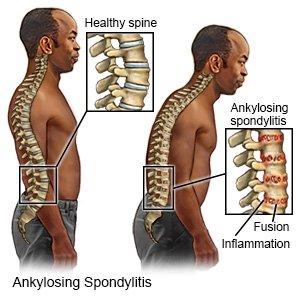What is Ankylosing Spondylitis?
Ankylosing Spondylitis (AS) is a chronic autoimmune condition where the body’s immune system, which normally protects against infections, mistakenly attacks the spine, joints, and surrounding tissues. This causes inflammation, pain, stiffness, and may eventually lead to joint fusion if not treated early.
In some patients, AS can also affect joints outside the spine, such as knees, ankles, or wrists. This is called peripheral spondyloarthritis.
How is AS Diagnosed?
Diagnosis is based on clinical examination, history of inflammatory back pain, and imaging tests. Blood tests may also be done to check for inflammation and the HLA-B27 gene.
Imaging: MRI of sacroiliac joints or spine can show early changes.
Why Early Treatment is Critical
AS can cause irreversible spinal fusion if not treated. Early treatment:
- Reduces pain and stiffness
- Prevents spinal damage
- Maintains posture and flexibility
- Reduces complications such as reduced chest expansion
Treatment Overview
1. NSAIDs
- First-line treatment to reduce inflammation and stiffness
- Examples: Naproxen, Etoricoxib
2. Physiotherapy
- Most important long-term treatment
- Daily posture and flexibility exercises
- Swimming, stretching, deep breathing exercises help
3. DMARDs
- For peripheral arthritis, sulfasalazine or methotrexate may be used
4. Biologic & Targeted Therapies
- If NSAIDs and physiotherapy do not control symptoms
- Anti-TNF injections (e.g. Adalimumab, Etanercept)
- JAK inhibitors (e.g. Tofacitinib) – newer oral options
- Patients must be screened for TB and hepatitis before starting biologics
Lifestyle & Joint Protection
- Maintain good posture during sitting, standing, and walking
- Avoid prolonged inactivity or poor posture
- Daily exercises are essential to prevent stiffness
- Avoid smoking – worsens spinal damage
- Weight control and healthy diet improve outcomes
Spondylitis Association of America- Exercise Guidance for Spondyloarthritis
Daily exercise routines tailored for spondyloarthritis, including ankylosing spondylitis:
Key components:
- Stretching (range of motion) — vital for stiffness control and preventing joint fusion.
- Aerobic exercises — 75–150 minutes per week (e.g., walking, swimming) for heart-lung health and reduced fatigue.
- Strength training — especially core strengthening 2–4 times weekly to support the spine and posture.
- Balance exercises — performed 3–5 times weekly to aid stability and reduce fall risk.
Samples available:
A downloadable exercise flyer and brochure
Team Care: Rheumatologist + Physiotherapist
- Rheumatologist: medication and disease monitoring
- Physiotherapist: exercise guidance and rehabilitation
When to Contact Your Doctor
- New or worsening back or joint pain
- Eye redness, pain, or vision changes
- Fever, cough, or chest symptoms while on treatment
